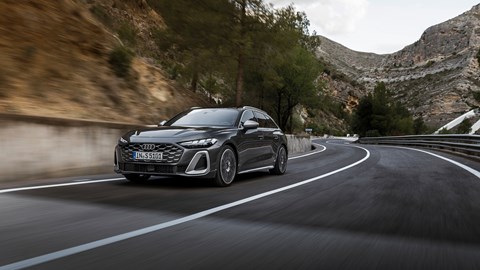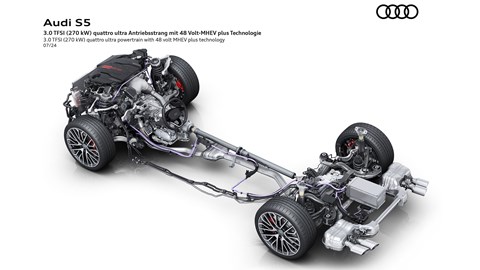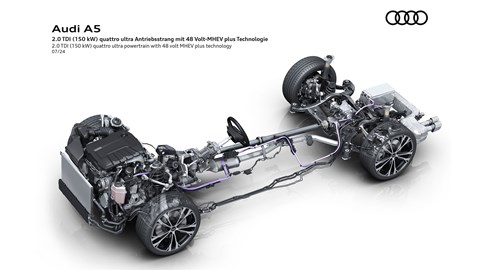► We break down Audi’s new MHEV Plus system
► Tech will help to keep petrol Audis around longer
► Potential to last beyond the 2035 ban, if need be
Audi has made a rather bold business decision. The brand has shifted its focus away from electric cars and launched a new, combustion-only vehicle architecture that’s designed to underpin everything from the new A5 to the future replacement for the Q7.
Audi has dubbed its new chassis ‘Premium Platform Combustion’ (or PPC for short). And if you’re a keen chassis code twitcher, you’ve probably already realised that it was designed to be the dinosaur-burning equivalent to the company’s new Premium Platform Electric (PPE) underpinnings.

PPC was developed specifically for use by Audi. We have it on good authority from the project’s lead engineers that the same underpinnings can’t be used to prop up cars like the next Volkswagen Golf or Skoda Octavia. That’s because its engines are mounted longitudinally rather than transversely, which won’t work with those cars’ packaging limitations.
To complement PPC, Audi has designed a fresh range of fossil fuel engines that are teamed with a brand-spanking new 48-volt mild hybrid system called MHEV Plus. The technology will be available on all Audi’s future combustion cars – and, because it’s rather complicated, we thought it’d be best to explain how it works in a separate page.
So, what makes MHEV Plus so complicated?
As the name suggests, MHEV Plus is a more sophisticated reimagining of mild hybrid technology. It uses two electric motors and a beefy 1.76kWh battery pack to both improve the efficiency of Audi’s engines and increase their performance.
Those two electric motors aren’t exactly where you’d expect them to be, though. There’s a belt-driven starter generator bolted to the engine and a ‘drivetrain generator’ mounted on the back of the gearbox. This second unit is the important one. It’s an electric motor about the size of a loaf of bread – and Audi went through the trouble of designing it because it’s more efficient at harvesting power when the car is decelerating.

Instead of only relying on the rotational mass of the engine (like a belt-driven starter-generator), Audi’s drivetrain generator can capitalise on the mass of the entire car and the additional torque from the rotating wheels to generate more electricity, faster.
This is important, because the battery pack for MHEV Plus is a lot larger than your average mild hybrid car’s. For context, the Ford Puma MHEV uses a 0.38kWh battery for its 48-volt mild hybrid powertrain. Audi’s MHEV Plus battery is more than 4.5 times larger than that, which allows the powertrain to acts more like a full hybrid system in use.
What benefits does MHEV Plus bring?
Primarily, it’ll allow Audi to extend the life of its combustion engines well into the 2030s. The brand’s customers have made it quite clear that they’re not all ready to make the switch to an electric car just yet – and Kerstin Englhardt, project leader for the PPC architecture, told us she was ‘convinced’ petrol and diesel engines will play a part in Audi’s future, right up until the EU ban.
Audi says it has a more intelligent power management system that your average mild hybrid system, too, because the system uses electricity almost as quickly as it generates it. The result is better fuel economy and lower CO2 emissions. In fact, Audi claims MHEV Plus trims 10g/km on its newly developed 2.0-litre diesel engine and 17g/km on its fresh 3.0-litre V6 engine for its S-badged cars. That’s significant.

The electric motor on the back of the gearbox can also power the new A5 all on its own at speeds of up to 18mph. That means you can creep through urban traffic or park up entirely on electric power.
Once you’re up to speed, MHEV Plus can keep Audi’s new generation of combustion cars ticking along at speed of up to 87mph, helping to reduce fuel consumption on the motorway. And if you need to zap past a dawdling wagon, the tech chucks an extra 24bhp at whatever powertrain its bolted to when you mat the gas.
Final fuel economy figures are yet to be confirmed, but Audi tells us the tech saves 0.38 litres of fuel per 100km on its new diesel and 0.74 litres of fuel per 100km on its new V6.